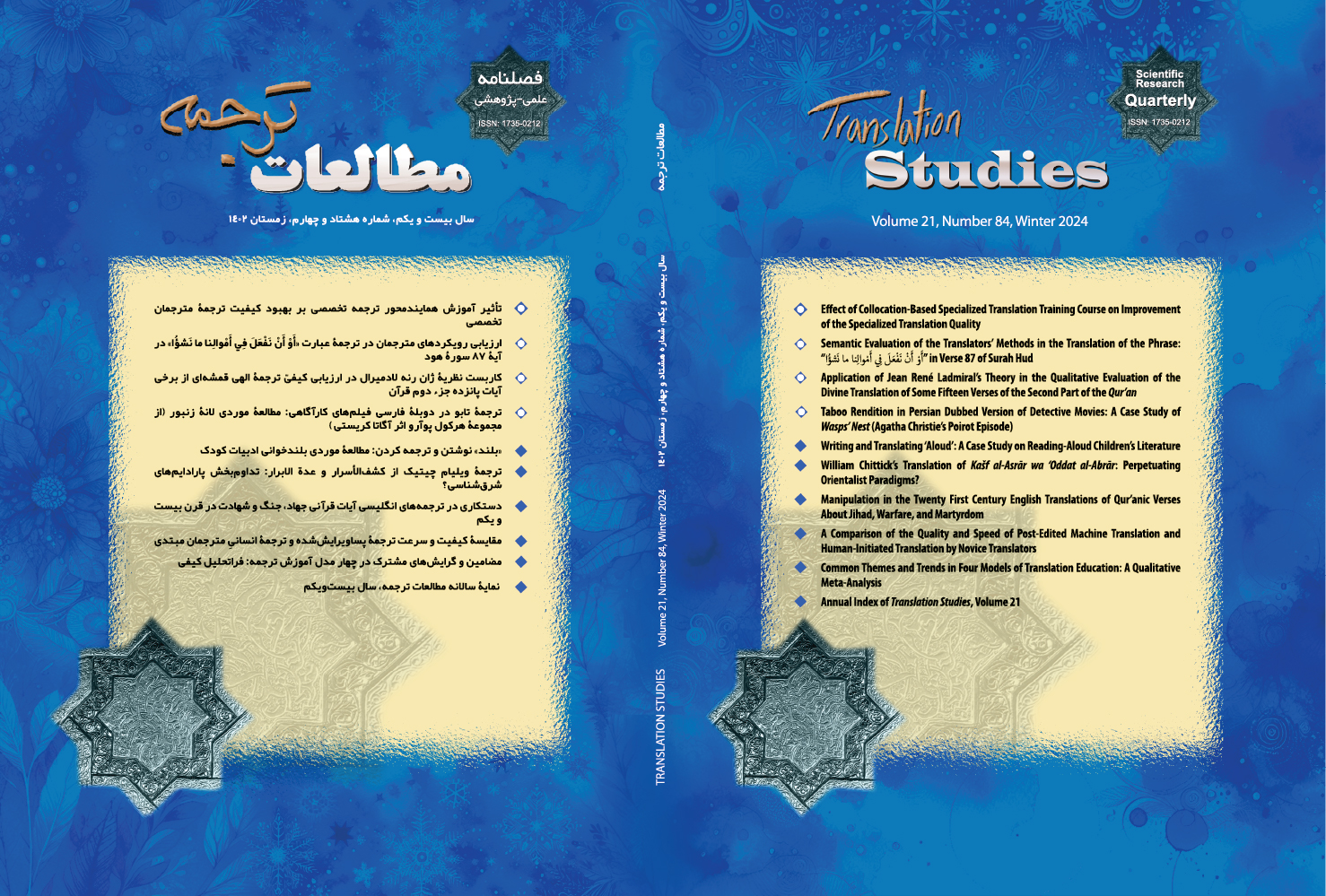مقایسۀ کیفیت و سرعت ترجمۀ پساویرایششده و ترجمۀ انسانی مترجمان مبتدی
چکیده
در پژوهش حاضر، پساویرایش و ترجمه انسانیِ مترجمان مبتدی از زبان انگلیسی به فارسی را از منظر کیفیت و سرعت مقایسه کردیم. همچنین، عوامل مؤثر بر مؤلفههای ذهنی و زمانی زحمت پساویرایش را بررسی نمودیم. بدین منظور، به ۱۰ دانشجوی کارشناسی مترجمی زبان انگلیسی دستورالعمل لازم داده شد تا متن خبری انگلیسی کوتاهی را از طریق پساویرایش خروجی خام ماشینِ ترجمه به فارسی ترجمه کنند، و همزمان به ۸ دانشجوی دیگر دستورالعملی داده شد تا همان متن را بدون استفاده از ترجمۀ ماشینی ترجمه کنند. هر دو گروه این ترجمه را در ابزار مترجمیار برخط مِیتکَت انجام دادند. بر عملکرد شرکتکنندگان حین ترجمه نظارت شد و با هدف مقایسۀ سرعت دو گروه هنگام ترجمه، تصویر صفحۀ نمایش رایانه مترجمان نیز ضبط گردید. در مرحله بعد، سه ارزیاب ترجمههای دو گروه را به دو صورت تحلیلی و کلنگر ارزیابی کردند. نتایج حاکی از این بود که سرعت عملکرد پساویرایشگران و کیفیت متون مقصد آنها بسیار بالاتر است. همچنین از شرکتکنندگان درخواست شد که پس از پایان فرآیند ترجمه پرسشنامهای را برای ارائۀ نظرات خود دربارۀ زحمت ذهنی و زمانی این فرآیند تکمیل کنند. پاسخهای شرکتکنندگان نشان داد که اشتباهات دستوری موجود در خروجی خام ماشینِ ترجمه مهمترین عاملیست که زحمت زمانی پساویرایش را تحت تأثیر قرار میدهد؛ همچنین، یافتن «معادلهای مناسب»، و ایجاد تعادل در میزان استفاده از خروجی ماشین ترجمه نیز با بسامد کمتری گزارش شده بود. یکی از شرکتکنندگان به اصلاح نیمفاصله نیز اشاره کرده بود. در میان عوامل مرتبط با زحمت ذهنی پساویرایش، تأثیر منفی پساویرایش بر خلاقیت مترجم از دغدغههای بارز شرکتکنندگان بود. همچنین، طبق نظر شرکتکنندگان، یافتن «معادلهای مناسب»، ایجاد تعادل در استفاده از خروجی ماشین ترجمه و ارائه متنی که خواندن آن راحت باشد در زمره مواردی بود که بر زحمت ذهنی پساویرایش تأثیر میگذارد.
کلمات راهنما:
پساویرایش ترجمه ماشینی، زحمت پساویرایش، ابزارهای مترجمیار، کیفیت ترجمه، مترجم مبتدیمراجع
Alves, F., Koglin, A., Mesa-Lao, B., Martínez, M. G., de Lima Fonseca, N. B., de Melo Sá, A., Gonçalves, J. L., Szpak, K. S., Sekino, K., & Aquino, M. (2016). Analysing the impact of interactive machine translation on post-editing effort. In M. Carl, S. Bangalore, & M. Schaeffer (Eds.), New directions in empirical translation process research: Exploring the CRITT TPR-DB (pp. 77–94). Springer International Publishing. https://doi.org/10.1007/978-3-319-20358-4_4
Alves, F., Szpak, K., Gonçalve, J., Sekino, K., Aquino, M., Castro, R., Koglin, A., & Fonseca, N. (2016). Investigating cognitive effort in post-editing: A relevance-theoretical approach. Language Science Press, 2, 109–142. https://doi.org/10.17169/langsci.b108.296
Aranberri, N., Labaka, G., Diaz de Ilarraza, A., & Sarasola, K. (2014). Comparison of post-editing productivity between professional translators and lay users. In S. O’Brien, M. Simard, & L. Specia (Eds.), Proceedings of the 11th conference of the Association for Machine Translation in the Americas (p. 20–33). Association for Machine Translation in the Americas.
Aziz, W., Castilho, S., & Specia, L. (2012). PET: A tool for post-editing and assessing machine translation. In In N. Calzolari, K. Choukri, T. Declerck, M. U. Doğan, B. Maegaard, J. Mariani, A. Moreno, J. Odijk, & S. Piperidis (Eds.), Proceedings of the eighth international conference on language resources and evaluation (pp. 3982–3987). European Language Resources Association.
Carl, M. (2012). Translog-ii: A program for recording user activity data for empirical reading and writing research. In In N. Calzolari, K. Choukri, T. Declerck, M. U. Doğan, B. Maegaard, J. Mariani, A. Moreno, J. Odijk, & S. Piperidis (Eds.), Proceedings of the eighth international conference on language resources and evaluation (pp. 4108–4112). European Language Resources Association.
Carl, M., Dragsted, B., Elming, J., Hardt, D., & Jakobsen, A. L. (2011). The process of post-editing: A pilot study. In B. Sharp, M. Zock, M. Carl, & A. L. Jakobsen (Eds.), Proceedings of the 8th international NLPCS workshop (pp. 131–142). Copenhagen Studies in Language.
Cumbreño, C., & Aranberri, N. (2021). What do you say? Comparison of metrics for post-editing effort. In M. Carl (Ed.), Explorations in empirical translation process research (pp. 57–79). Springer International Publishing. https://doi.org/10.1007/978-3-030-69777-8_3
Daems, J., Vandepitte, S., Hartsuiker, R., & Macken, L. (2017). Translation methods and experience: A comparative analysis of human translation and post-editing with students and professional translators. Meta, 62(2), 245–270. https://doi.org/10.7202/1041023ar
Eyckmans, J., Anckaert, P., & Segers, W. (2009). The perks of norm-referenced translation evaluation. In C. V. Angelelli & H. E. Jacobson (Eds.), Testing and assessment in translation and interpreting studies (pp. 73–94). John Benjamins Publishing Company.
Garcia, I. (2010). Is machine translation ready yet. Target, 22(1), 7–21.
Hutchins, W. J., & Somers, H. L. (1992). An introduction to machine translation. Academic Press.
Jia, Y., Carl, M., & Wang, X. (2019). How does the post-editing of neural machine translation compare with from-scratch translation? A product and process study. The Journal of Specialised Translation, 31, 60–86.
Koby, G. S. (2001). Editor’s introduction: Post-editing of machine translation output: Who, what, why, and how (much). In H. P. Krings, Repairing texts: Empirical investigations of machine translation post-editing processes (pp. 1–24). Kent State University Press.
Koehn, P. (2009). A process study of computer-aided translation. Machine Translation, 23, 241–263. https://doi.org/10.1007/s10590-010-9076-3
Krings, H. P. (2001). Repairing texts: Empirical investigations of machine translation post-editing processes. Kent State University Press.
Läubli, S., Amrhein, C., Düggelin, P., Gonzalez, B., Zwahlen, A., & Volk, M. (2019). Post-editing productivity with neural machine translation: An empirical assessment of speed and quality in the banking and finance domain. In M. Forcada, A. Way, B. Haddow, & R. Sennrich (Eds.), Proceedings of machine translation summit XVII: Research (pp. 267–272). European Association for Machine Translation.
Lee, J., & Liao, P. (2011). A comparative study of human translation and machine translation with post-editing. Compilation & Translation Review, 4(2). 105–149.
Nitzke, J., & Oster, K. (2016). Comparing translation and post-editing: An annotation schema for activity units. In M. Carl, S. Bangalore, & M. Schaeffer (Eds.), New directions in empirical translation process research: Exploring the CRITT TPR-DB (pp. 293–308). Springer International Publishing. https://doi.org/10.1007/978-3-319-20358-4_14
O'Brien, S. (2005). Methodologies for measuring the correlations between post-editing effort and machine translatability. Machine Translation, 19, 37–58. https://doi.org/10.1007/s10590-005-2467-1
O'Brien, S. (2007). Eye-tracking and translation memory matches. Perspectives, 14(3), 185–205. https://doi.org/10.1080/09076760708669037
Plitt, M., & Masselot, F. (2010). A productivity test of statistical machine translation post-editing in a typical localisation context. The Prague Bulletin of Mathematical Linguistics, 93, 7–16. https://doi.org/10.2478/v10108-010-0010-x
Skadiņš, R., Puriņš, M., Skadina, I., & Vasiļjevs, A. (2011). Evaluation of SMT in localization to under-resourced inflected language. In M. L. Forcada, H. Depraetere, & V. Vandeghinste (Eds.), Proceedings of the 15th annual conference of the European Association for Machine Translation (pp. 35–40). European Association for Machine Translation.
Vieira, L. N. (2014). Indices of cognitive effort in machine translation post-editing. Machine Translation, 28, 187–216. https://doi.org/10.1007/s10590-014-9156-x
Downloads
چاپشده
ارجاع به مقاله
شماره
نوع مقاله
DOR
مجوز
حق نشر 2024 S. Hossein Arjani, Masoud Jamshidiha

این پروژه تحت مجوز بین المللی Creative Commons Attribution-NonCommercial 4.0 می باشد.
Copyright Licensee: Iranian Journal of Translation Studies. This article is an open access article distributed under the terms and conditions of the Creative Commons Attribution–NonCommercial 4.0 International (CC BY-NC 4.0 license).





